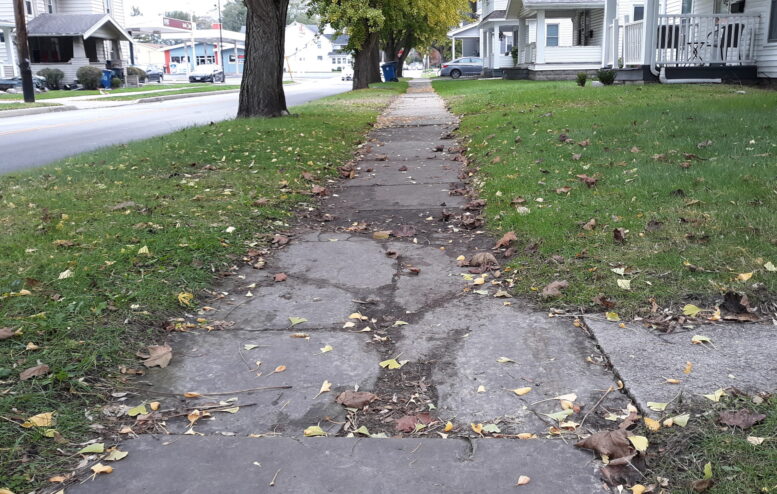By JAN McLAUGHLIN
BG Independent News
For the past few years, Bowling Green sidewalks have been traversed by food-delivering robots. More recently, the city sidewalks were traveled by videotaping robots collecting information on sidewalk conditions.
The data collected has been put into a Sidewalk Condition Index for city officials.
The videos identify defects that could be hazardous to pedestrians, such as separations, heaving due to tree roots, holes, cracks, slopes, missing panels, and uneven spots.
The sidewalk surveillance was shown by BG Public Works Director Mick Murray during a meeting last month of the city’s Sidewalk Commission. A map of the city shows sidewalks in different colors depending on their condition.
The index is intended to help city officials make decisions about prioritizing sidewalk repairs. In addition to the hazardous conditions, the sidewalks are also scored based on their proximity to schools and the downtown.
Property owners within selected project areas will be responsible for 50% of their replacement cost, with the city covering the remaining 50%. The 50/50 split program is only available to one- and two-family residences on public streets.
Property owners will receive a notification by certified mail detailing the project scope, timeframe, and an approximate cost estimate.
Projects will be prioritized according to SCI scores, with lower scores and missing sidewalk panels receiving top priority. Sidewalk hazards reported by residents will be reviewed and, if warranted, added to the project list.
Contiguous sidewalk segments (typically spanning from intersection to intersection) containing severe defects across the entire length, will receive additional weighting in the ranking system. This ensures that areas requiring comprehensive repairs are prioritized, optimizing work efficiency.
A funding cut-off will be established based on the available annual budget. Estimated project costs will be calculated.
The city has $75,000 available this year for these projects, said Murray. The average sidewalk on a residential property costs $4,000 to $4,500 to install. Using the city’s 50/50 program, that means between 30 and 35 sidewalks can be replaced, he said.
However, Murray also said the cost to replace sidewalks has gone up quite a bit – costing $12 per linear foot last year, to $20 this year.
The first round of these sidewalk replacements using the SCI scores will be selected by Aug. 1 and be constructed next year.
Using the Sidewalk Condition Index (SCI), software will prioritize 50/50 requests, placing the lowest-scoring requests first. A funding cut-off will be established based on available funding. Requests that fall below the cut-off will be deferred to the following year.
If possible, the new sidewalks will be wider than the previous standard of 4 feet. However, in the older subdivisions, they will likely stay 4 feet wide, but will be ADA compliant, Murray said.
Municipal Administrator Lori Tretter noted that landowners have long been responsible for maintaining their sidewalks.
“Everyone uses the sidewalks,” Tretter said. “Maintaining what we have is important to everyone’s mobility.”
The SCI scores, based on videotaped evidence, provide a fair way to operate the sidewalk replacement program, she added.
“I want to say thank you for that report,” Debbie Thompson, who uses a wheelchair and depends on good sidewalks, said during the meeting last month.
Also during the Sidewalk Commission meeting, Murray presented the following on public works sidewalk projects in 2025:
- In addition to any utility work that necessitated sidewalk removal over the winter, Public Works will also repair missing panels on 16 properties resulting from past utility work.
- Infill on Mercer Road from Clough Street south to the future rapid flashing beacon crossing that will lead to the Crim Shared Use Path.
- Infill on Leroy Avenue between North Summit and Enterprise streets.

